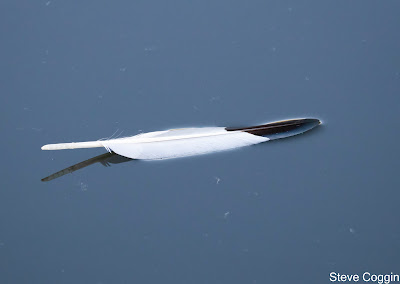 |
| Kudzu (Pueraria montana) growing over trees. Rowan County, North Carolina. |
Kudzu (Pueraria montana) is a famous, nay infamous, invasive vine from Asia. It was introduced to the United States, like many invasive species, with good intentions. It was imported as an ornamental plant in the late 19th century and was used by United States Soil Conservation Service in the early 20th century to control erosion in the south. Kudzu is known as "the vine that ate the south" and grows over fields, trees, power poles and buildings.
 |
| A trifoliate compound leaf of Kudzu. Rowan County, North Carolina. |
 |
| Early spring Kudzu vine. Rowan County, North Carolina. |
 |
| Twining vines of Kudzu. Rowan County, North Carolina. |
 |
| Kudzu growing over a house. Rowan County, North Carolina. |
Kudzu is a member of the Fabaceae, the pea family. It has large, trifoliate compound leaves and hairy stems. Like many members of this family, Kudzu roots harbor nitrogen fixing bacteria that allows the vine to thrive in even the poorest soils. Kudzu has large tap roots resembling sweet potatoes that are rich in starch. In late summer, Kudzu produces inflorescences of beautiful purple and yellow flowers that smell of grape jelly. In fall, Kudzu makes a hairy pod containing bean-like seeds.
 |
| A Kudzu inflorescence. The inflorescence blooms from the bottom up. Rowan County, North Carolina. |
 |
| A closeup of a Kudzu flowers. Rowan County, North Carolina. |
 |
| Kudzu fruits. Rowan County, North Carolina. |
While the plants do make seeds, Kudzu usually spreads by vegetative growth. Stems that make contact with the soil make new roots and with a growth rate of a foot per day, the vines can ramble long distances in a single growing season. Kudzu can kill other vegetation including large trees when the leaves and vines block out light and the roots outcompete other plants.
 |
| Kudzu smothering trees. Rowan County, North Carolina. |
Control of Kudzu has proven difficult, and many methods have been tried. Mowing a stand of Kudzu for several seasons or grazing with goats can remove the invasive plants. Digging up the vines and herbicide application also works to get rid of Kudzu. The aerial portions of Kudzu are killed by the first hard freeze and that makes a landscape of brown leaves and vines. During the winter there is some decay of the dead vines but the following spring the plant begin its relentless growth again.
 |
| A stand of Kudzu in winter. Rowan County, North Carolina. |
In 2009 a new insect, Megacopta cribraia, started appearing in the counties around Atlanta, Georgia. This invasive insect is called the Kudzu Bug does feed on Kudzu, but it also causes severe damage to Soybean (Glycine max) crops. Kudzu Bugs are true bugs in the Order Hemiptera and are native to East Asia, the same area that gave us Kudzu. Kudzu Bugs are small, about ¼ inch long, dark brown and emit a foul, stinkbug-like odor when disturbed. Besides living on Kudzu and eating Soybean plants, this bug is also a pest around homes. Kudzu bugs are attracted to white or yellow buildings and can congregate in large numbers on houses. This new invasive insects probably arrived from Asia as stowaways on an airliner. Since their arrival in 2009 Kudzu Bugs have spread out from Georgia and are now found from Texas to New Jersey and are a major concern for Soybean farmers.
 |
| A Kudzu Bug (Megacopta cribraria) on a Kudzu leaf. Rowan County, North Carolina. |
 |
| A group of Kudzu Bugs on a Kudzu leaf. Rowan County, North Carolina. |
When Kudzu arrived in North America it found a favorable habitat with few natural enemies, and so it spread. Kudzu now grows from Florida to the Midwest and into Mid-Atlantic states. Contrary to some rumors, Kudzu Bugs were not intentionally introduced to control Kudzu. Although the bugs do reduce the growth of the vine, it is unlikely this second invasive species will stop the march of the "vine that ate the south".
 |
| A Kudzu landscape. Rowan County, North Carolina. |













